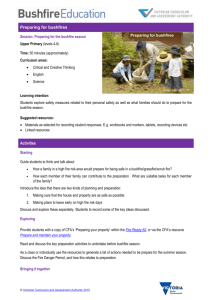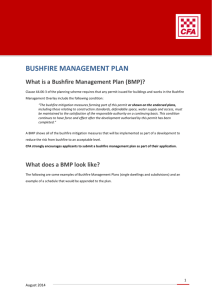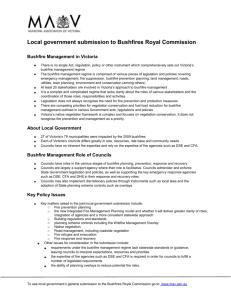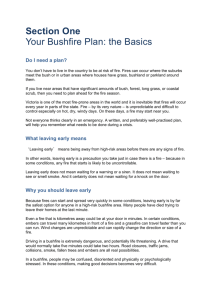Bushfire tools and products - Department of Transport, Planning and
advertisement
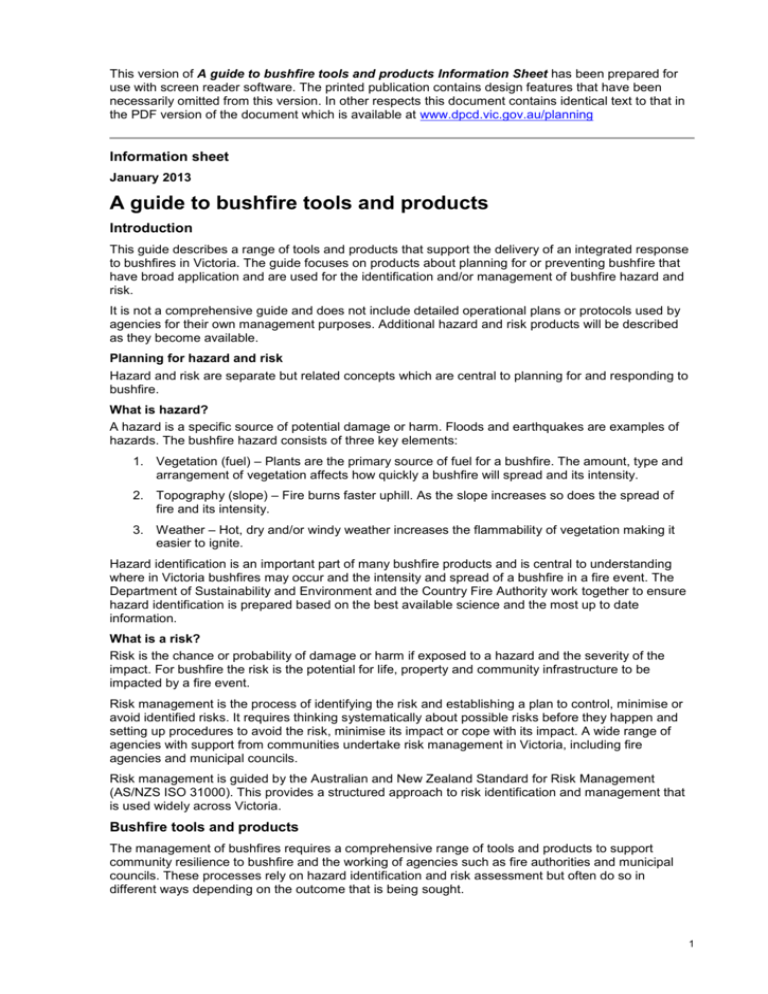
This version of A guide to bushfire tools and products Information Sheet has been prepared for use with screen reader software. The printed publication contains design features that have been necessarily omitted from this version. In other respects this document contains identical text to that in the PDF version of the document which is available at www.dpcd.vic.gov.au/planning Information sheet January 2013 A guide to bushfire tools and products Introduction This guide describes a range of tools and products that support the delivery of an integrated response to bushfires in Victoria. The guide focuses on products about planning for or preventing bushfire that have broad application and are used for the identification and/or management of bushfire hazard and risk. It is not a comprehensive guide and does not include detailed operational plans or protocols used by agencies for their own management purposes. Additional hazard and risk products will be described as they become available. Planning for hazard and risk Hazard and risk are separate but related concepts which are central to planning for and responding to bushfire. What is hazard? A hazard is a specific source of potential damage or harm. Floods and earthquakes are examples of hazards. The bushfire hazard consists of three key elements: 1. Vegetation (fuel) – Plants are the primary source of fuel for a bushfire. The amount, type and arrangement of vegetation affects how quickly a bushfire will spread and its intensity. 2. Topography (slope) – Fire burns faster uphill. As the slope increases so does the spread of fire and its intensity. 3. Weather – Hot, dry and/or windy weather increases the flammability of vegetation making it easier to ignite. Hazard identification is an important part of many bushfire products and is central to understanding where in Victoria bushfires may occur and the intensity and spread of a bushfire in a fire event. The Department of Sustainability and Environment and the Country Fire Authority work together to ensure hazard identification is prepared based on the best available science and the most up to date information. What is a risk? Risk is the chance or probability of damage or harm if exposed to a hazard and the severity of the impact. For bushfire the risk is the potential for life, property and community infrastructure to be impacted by a fire event. Risk management is the process of identifying the risk and establishing a plan to control, minimise or avoid identified risks. It requires thinking systematically about possible risks before they happen and setting up procedures to avoid the risk, minimise its impact or cope with its impact. A wide range of agencies with support from communities undertake risk management in Victoria, including fire agencies and municipal councils. Risk management is guided by the Australian and New Zealand Standard for Risk Management (AS/NZS ISO 31000). This provides a structured approach to risk identification and management that is used widely across Victoria. Bushfire tools and products The management of bushfires requires a comprehensive range of tools and products to support community resilience to bushfire and the working of agencies such as fire authorities and municipal councils. These processes rely on hazard identification and risk assessment but often do so in different ways depending on the outcome that is being sought. 1 The tools and products used most extensively in Victoria are set out below. They include joint agency working, various maps and printed material, as well as formalised risk assessments. Links are also included so that more information can be obtained from the agency leading on the various activities. Integrated Fire Management Planning (IFMP) Lead Agency: Fire Services Commissioner. Type: Joint agency working. Products: State Fire Management Strategy; Regional Strategic Fire Management Plans. Integrated Fire Management Planning brings together a range of agencies and organisations to discuss, plan and manage fire in the community. These organisations are responsible for fire prevention, preparedness, response, recovery and cultural and environmental uses of fire. IFMP involves organisations through the establishment of state, regional and municipal committees, through which members have the opportunity to better understand each other’s roles in fire management planning and bring their individual plans together. Key agencies involved in IFMP are municipal councils, the Country Fire Authority, the Metropolitan Fire and Emergency Services Board and the Department of Sustainability and Environment. Further information: http://www.ifmp.vic.gov.au/ Municipal Fire Management Planning Lead Agency: Municipal councils. Type: Joint agency working. Products: Municipal Fire Management Plans. Municipal Fire Management Planning integrates planning at the municipal and local level. Working through a Municipal Fire Management Planning Committee, members work collaboratively to produce a Municipal Fire Management Plan. This plan is prepared in accordance with the Country Fire Authority Act 1958 and sets out the key actions and commitments to be taken at a municipal level. Further information: http://www.ifmp.vic.gov.au/index.php/regional-committee Planning Schemes Lead Agency: Department of Planning and Community Development. Type: Statutory. Products: Bushfire Management Overlay. Planning schemes set out policies and provisions for the use, development and protection of land. Each local government area in Victoria, and some special planning areas, is covered by a planning scheme. Planning schemes are legal documents prepared by the municipal council or the Minister for Planning, and approved by the Minister for Planning. All planning schemes in Victoria include the State Planning Policy for Bushfire which sets out how the planning system should incorporate bushfire considerations into planning decisions. Included in planning schemes is the Bushfire Management Overlay. This is a tool which applies to land where bushfire considerations must be taken into account when planning decisions are made. The Bushfire Management Overlay applies to areas where there is potential for extreme bushfire behaviour, such as a crown fire and extreme ember attack and radiant heat. The Bushfire Management Overlay is applied based on the bushfire hazard. It is not a risk assessment as risk is considered as part of the planning application process. Further information: http://www.dpcd.vic.gov.au/planning/planningschemes/about-planning-schemes Regional Bushfire Planning Assessments Lead Agency: Department of Planning and Community Development. Type: Information. Products: Regional Bushfire Planning Assessment for all regions in Victoria. Regional Bushfire Planning Assessments provide information about areas where a range of land use planning matters intersects with a bushfire hazard. This information is relevant when planning for existing and future settlements. The Assessments focus on factors that are particularly important to 2 land use planning such as access and interface areas. The information is shown spatially on a series of maps for each municipality. Further information: www.dpcd.vic.gov.au/planning/bushfire Building Regulations Lead Agency: Department of Planning and Community Development. Type: Statutory. Products: Designated Bushfire prone area. Building Regulations are derived from the Building Act 1993 and contain amongst other things, the requirements relating to building permits, building inspections, occupancy permits, enforcement of the Regulations and maintenance of buildings. The Building Regulations call up the Building Code of Australia as a technical reference that must be complied with. Bushfire prone areas identify areas of the state that are deemed to be bushfire prone and triggers specific building regulation requirements regarding the type and form of construction required. These areas are declared under the Building Regulations by the Minister for Planning. Bushfire prone areas are identified based on the bushfire hazard. They are not risk assessments as risk is considered as part of the building permit process. AS3959 – 2009 Building in a bushfire prone area (Standards Australia) is used to determine the construction requirements for new buildings. Under the Building Regulations new buildings in a Bushfire prone area must be built to a minimum standard that accounts for ember attack. Further information: www.dpcd.vic.gov.au/bushfireproneareas Victorian Fire Risk Register (VFRR) Lead Agency: Country Fire Authority. Type: Information. Products: Fire risk register for each municipality. The VFRR and its associated processes inform and support fire management planning and service delivery at all levels. It is a register that identifies and describes the level of risk for various assets or places exposed to the risk of bushfire. The register is informed by the nature of the asset, the level of hazard and the influence of strategies designed to address the risk. It is prepared with input from municipal councils, the Country Fire Authority, and the Department of Sustainability and Environment. Further information: www.cfa.vic.gov.au Fire hazard ratings for powerlines Lead Agency: Country Fire Authority. Type: Statutory. Products: Low Fire Hazard Ratings (Powerline Vegetation Clearance) map. Under Section 80 of the Electricity Safety Act 1998, the CFA and the Metropolitan Fire and Emergency Services Board (MFB) assign low and high fire hazard ratings to the Country Area of Victoria and to portions of the Metropolitan Fire District. The assignment of low and high fire hazard ratings aims to safeguard life and property by preventing overhead electric line-related ignitions on land-uses where such ignitions have the potential to cause damage to life, property and/or the environment. The potential for significant bushfire spread (encompassing grassfire through to forest fire) and resultant damage is assessed on different landuses through the application of worst-case scenario weather conditions. Further information: www.cfa.vic.gov.au Community Information Guides Lead Agency: Country Fire Authority. Type: Information. Products: Community Information Guides for selected locations across Victoria. Community Information Guides are prepared by the CFA in conjunction with local councils and other agencies to describe local bushfire risk mitigation and fire mitigation actions that will be implemented 3 for a particular township. Community Information Guides draw on a wide range of information, including that contained in the Victorian Fire Risk Register. A Guide contains important community bushfire safety information provided to help both local residents and visitors to an area make informed decisions about bushfire survival options. It will typically include a description of the extent of hazard, an analysis of the risks posed by the hazard and a description of actions that will be implemented either prior to or during a bushfire event. Further information: www.cfa.vic.gov.au Neighbourhood Safer Places Lead Agency: Country Fire Authority. Type: Designated buildings or spaces. Products: Designated Neighbourhood Safer Places throughout Victoria. Neighbourhood Safer Places are municipal council designated buildings or spaces within the community that may afford some protection from radiant heat, the biggest killer during bushfire. They may be used in a bushfire event as places of last resort to provide some protection from the life threatening effects of bushfire when all other plans have failed. They are identified and designated by local government in a Municipal Fire Management Plan. The degree of safety afforded by Neighbourhood Safer Places will depend on a number of factors, including the intensity of the bushfire. Neighbourhood Safer Places are not designed to replace a personal bushfire survival plan. CFA advises that everyone should have a written Bushfire Survival Plan. Further information: www.cfa.vic.gov.au ISBN 978-1-921940-90-3 Published by the Victorian Government Department of Planning and Community Development, Melbourne, January 2013. © The State of Victoria Department of Planning and Community Development 2013. This publication is copyright. No part may be reproduced by any process except in accordance with the provisions of the Copyright Act 1968. Authorised by the Victorian Government, 1 Spring Street, Melbourne. This publication may be of assistance to you but the State of Victoria and its employees do not guarantee that the publication is without flaw of any kind or is wholly appropriate for your particular purposes and therefore disclaims all liability for any error, loss or other consequence which may arise from you relying on any information in this publication. www.dpcd.vic.gov.au/planning DOCUMENT ENDS 4
